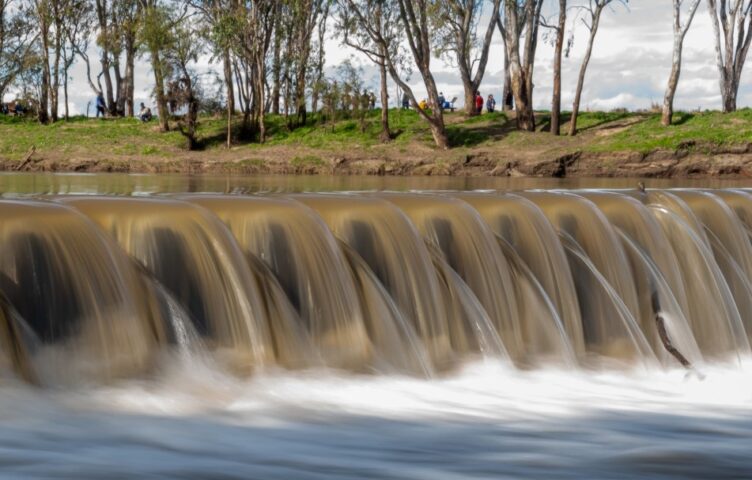QWMN 22/23 RD&I Final Showcase
Each year, the Queensland Water Modelling Network funds a range of Research, Development and Innovation (RD&I) projects. The seven (7) projects funded in the 22/23 cohort, were showcased on 29 August 2023, highlighting the outputs and findings from each project to the broader audience of interested water modelling and use practitioners, including Queensland Government staff.

The day began early with guests and speakers arriving at the Ecosciences Precinct from 8:30 AM. Facilitated by Brian McIntosh, we were Welcomed to Country by Turrbal Songwoman Maroochy Barambah, her creative storytelling and soothing song about the place on which we met. Dressed in traditional skins, Songwoman Maroochy offered her blessing, before Executive Director Water and Catchments, Science Division at DES Paul Lawrence opened proceedings. Paul spoke about the significance of water modelling RD&I in Queensland before project presenters were welcomed on stage. recordings of each presentation can be found by clicking on the links below.

The 2022 RD&I Project round saw funding across the following projects:
- Building trust and enhancing dialogue and collaboration in water modelling using animation: This project uses animated drawings and videos to enhance communication between water modellers, Traditional Owners and the wider community. This is important, because collaboration over the entire modelling life cycle has the potential to expand the knowledge base for model development and verification, ensuring models are fit for purpose and building trust in models – presented by Kate O’Brien (The University of Queensland), Travis Harbour (Jibija Ung-gwee) and Jim Hill (Yirendali Aboriginal Corporation) on behalf of the project team from, The University of Queensland, Ecofutures Consulting, Healthy Land and Water, Yirendali Aboriginal Corporation, Jibija Ung-gwee, Alluvium Consulting, Griffith University, Queensland University of Technology, Department of Environment and Science
- Eco-nomics for NRM planning and reporting: Eco-nomics: a natural resource management investment planning and impact reporting tool with a pilot in the Northern Murray Darling Basin. In partnership with Southern Queensland Landscapes, Truii will deliver the capacity to model the impacts of Natural Resource Management actions on biophysical parameters (water quality, and environmental metrics) and co-benefits (social, economic, First Nations, Climate) within the constraints of investment budget, adoption potential and temporal response of actions – presented by Nick Marsh (Truii) and Paul Webb (Southern Queensland Landscapes)
- Improving the flood resilience of a tropical urban catchment: Recent flooding events in Australia highlight the need to increase to survive and recover from future flooding events. This 1-year pilot project uses a LGA priority region, Saltwater Creek in Cairns, to better understand the impacts of flooding due to climate change and to explore ways to achieve place-based adaptation measures by working collaboratively with local government (Cairns Regional Council) and First Nations peoples – presented by Han-She Lim, James Cook University on behalf of the project team from: Gimuy Walubara Yidinji Elders Aboriginal Corporation, Abriculture), James Cook University, Cairns Regional Council, Gimuy Walubara Yidinji Elders Aboriginal Corporation and Abricultur
- Modelling Unseen flow pathways of water and contaminants in the Wet Tropics: Dried-up river channels (palaeochannels) may potentially be a fast route for transporting nutrient-rich water to the coast. This pilot, 1-year project seeks to understand and address gaps around palaeochannels and the roles they play in water and nutrient movement for Wet Tropics catchments – presented by Han-She Lim, James Cook University on behalf of the project team from James Cook University, Alluvium, Jaragun Ecoservices, Department of Resources, Department of Agriculture and Fisheries
- New catchment models for SEQ: A new project funded through the QWMN will see a new style of catchment modelling applied in the SEQ region. This model will use a gridded approach, where individual characteristics of the landscape can be represented on a cell by cell basis, rather than lumped, to capture more of the catchment complexity and therefore simulate more of the spatial variability of key processes – presented by Tony Weber (Alluvium) on behalf of the project team from Alluvium, BMT, Griffith University and Brisbane City Council
- Trialling customisation of a water quality model in an ungauged catchment for DIN : The UN Sustainable development goals call on decision makers to achieve reduction in land based nutrients entering marine systems by 2030. Water quality models are the tool used to quantify nutrient balances and inform the best investment decisions to achieve the targets. Current methods for modelling nutrient from catchments that flow to the Great Barrier Reef donate observed water quality data and parameters to neighbouring ungauged catchments. – presented by Cherie O’Sullivan (University of Southern Queensland) and Steve Burgess (Mary River Catchment Coordinating Committee) on behalf of the project team from University of Southern Queensland, Mary River Catchment Coordinating Committee and the Department of Environment and Science
- Incorporating First Nations Land Management into Technical Approaches to Water Modelling: A Pilot Study to Establish Frameworks to Incorporate Indigenous Knowledge (Relative Creative, Firesticks Alliance and Water Technology, with the cultural guidance of Mandandanji Traditional Owner, Aunty Kay Blades): This QWMN pilot project seeks to understand and address gaps within the water planning process to ensure that First Nations Land Management practices can be effectively integrated, alongside relevant models, into landscape rehabilitation and resilience. The project focusses on the community of St George in the Northern Murray Darling Basin. Working collaboratively and across multiple disciplines Relative Creative (First Nations-led strategic designers and visual communication designers), Firesticks Alliance (First Nations land management practitioners) and Water Technology (water, engineering and environmental consultants) will progress the project under the cultural guidance and authority of Mandandanji Traditional Owner, Aunty Kay Blades. – presented by Bec Barnett (Relative Creative)
For more details on each project, please visit – https://science.des.qld.gov.au…




